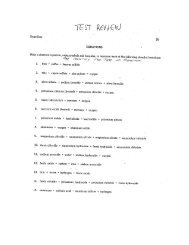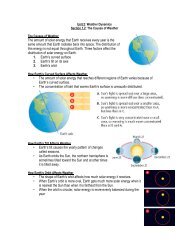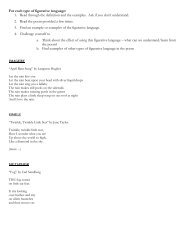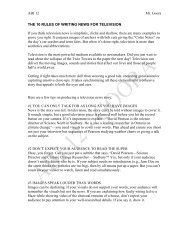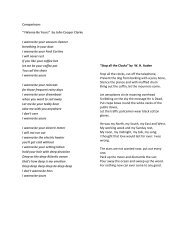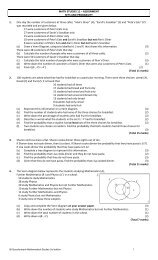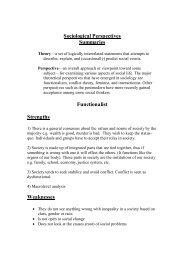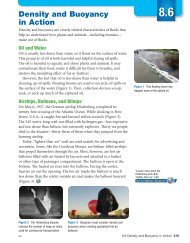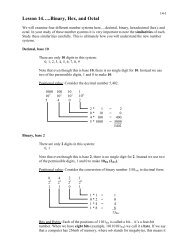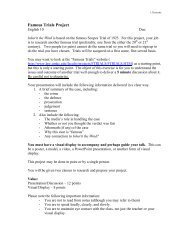Chemistry 12 Measuring Reaction Rate Using Volume of Gas ...
Chemistry 12 Measuring Reaction Rate Using Volume of Gas ...
Chemistry 12 Measuring Reaction Rate Using Volume of Gas ...
Create successful ePaper yourself
Turn your PDF publications into a flip-book with our unique Google optimized e-Paper software.
Abstract<br />
<strong>Chemistry</strong> <strong>12</strong><br />
<strong>Measuring</strong> <strong>Reaction</strong> <strong>Rate</strong> <strong>Using</strong> <strong>Volume</strong> <strong>of</strong> <strong>Gas</strong><br />
Produced<br />
From previous lectures, the effect <strong>of</strong> various factors on the rate <strong>of</strong> a chemical reaction<br />
was demonstrated. In these demonstrations, the time required to complete the reaction<br />
was measured and a reaction rate was calculated from that quantity. In addition to finding<br />
the time required for a reaction to go to completion, chemists frequently need to know<br />
what the rate is at different times during a reaction, in order to monitor how the reaction<br />
is proceeding. This information is obtainable in a variety <strong>of</strong> ways. For instance, if a gas is<br />
produced in a closed container, then continuous monitoring <strong>of</strong> the pressure indicates the<br />
rate. If a color is produced or used up, monitoring <strong>of</strong> the color intensity with a<br />
spectrophotometer indicates the rate. If a gas is produced and allowed to escape from the<br />
system, the decrease in mass over various time intervals shows how the reaction is<br />
progressing. This latter method can easily be demonstrated with an electronic balance.<br />
When a flask containing hydrochloric acid is placed on the pan <strong>of</strong> an electronic balance<br />
and marble chips are dropped in, the decrease in mass with time gives a measure <strong>of</strong> the<br />
rate at which CO 2 is produced. Yet another method <strong>of</strong> monitoring the rate <strong>of</strong> a reaction<br />
involving gases is to measure the volume <strong>of</strong> gas produced by displacing water from a<br />
eudiometer (gas measuring tube). It is this latter method that will be used in this<br />
experiment.<br />
Ordinary household bleach is an aqueous solution <strong>of</strong> Sodium hypochiorite, NaClO,<br />
containing a little more than 5% NaClO by mass. The bleaching action is caused by the<br />
hypochiorite ion, ClO - . Under normal circumstances the hypochlorite ion breaks down<br />
slowly to give oxygen gas and the chloride ion, Cl - .<br />
2 ClO - (aq) → 2 Cl - (aq) + O 2(g)<br />
To speed this reaction to a measurable rate a catalyst is required. In this experiment, the<br />
catalyst is provided by the addition <strong>of</strong> Cobalt (II) nitrate solution to the bleach. A black<br />
precipitate <strong>of</strong> Cobalt (III) oxide forms and acts as the catalyst for the decomposition <strong>of</strong><br />
ClO - . The volume <strong>of</strong> oxygen produced is measured at 30 second intervals by displacing<br />
water from a eudiometer. From the results, you can plot a graph <strong>of</strong> gas volume produced<br />
versus time and calculate the average rate <strong>of</strong> oxygen evolution in millilitres per minute.<br />
The experiment is repeated at other temperatures and concentrations <strong>of</strong> ClO - and the<br />
effect <strong>of</strong> these changes on the rate is observed.<br />
<strong>Chemistry</strong> <strong>12</strong> - 1 -
Purpose<br />
1. To measure the volume <strong>of</strong> a gas produced from a reaction mixture at regular time<br />
intervals during the reaction.<br />
2. To interpret the results and obtain the overall rate <strong>of</strong> reaction.<br />
3. To observe how the rate changes at different temperatures and concentrations<br />
Materials<br />
Apparatus<br />
250 mL Erlenmeyer flask 10 mL graduated cylinder<br />
One hole rubber stopper (#6) 2 x 600 mL beaker<br />
5 cm <strong>of</strong> glass tubing Thermometer<br />
Rubber tubing<br />
Source <strong>of</strong> hot water<br />
Eudiometer (50 mL)<br />
Ice<br />
Burret stand and clamp<br />
Lab apron<br />
25 mL graduated cylinder Safety goggles<br />
Stopwatch<br />
Hot plate<br />
Reagents<br />
5.25% Sodium hypochlorite<br />
0.10 M Cobalt (II) nitrate, Co(NO 3 ) 2<br />
Procedure<br />
1. Put on your lab apron and safety goggles.<br />
2. Refer to Figure 1 to help with understanding how to set up the apparatus.<br />
Figure 1:<br />
Set-up <strong>of</strong> the equipment<br />
for collection <strong>of</strong> gas.<br />
- 2 -
3. Fill the eudiometer with water and invert it into the 600 mL beaker (half-filled<br />
with water), without letting any water come out. Hold it in the vertical position<br />
with the buret clamp attached to the stand.<br />
4. Join the rubber tubing to the top <strong>of</strong> the glass tube which goes through the stopper<br />
on the flask. Place the other end into the neck <strong>of</strong> the eudiometer.<br />
5. Set up a hot water bath with another 600 mL beaker and your hot plate. The goal<br />
is to achieve a temperature <strong>of</strong> 10 o C above room temperature for use in step 11.<br />
6. Measure 15 mL <strong>of</strong> bleach solution into the 25 mL graduated cylinder and pour it<br />
into the Erlenmeyer flask.<br />
7. Measure 5 mL <strong>of</strong> 0.10 M Cobalt (II) nitrate solution into the 10 mL graduated<br />
cylinder.<br />
8. Pour the Cobalt (II) nitrate solution into the flask and immediately place the<br />
stopper and tube on it. Record the time <strong>of</strong> mixing.<br />
9. Note the formation <strong>of</strong> a black precipitate <strong>of</strong> Cobalt (III) oxide, Co 2 O 3 . From now<br />
on you must swirl the flask gently but continually. This is necessary to dislodge<br />
bubbles <strong>of</strong> oxygen from the surface <strong>of</strong> the Co 2 O 3 catalyst. If you stop swirling the<br />
rate decreases, so the amount <strong>of</strong> swirling must be kept uniform throughout this<br />
and subsequent steps <strong>of</strong> the procedure.<br />
10. Record the total volume <strong>of</strong> oxygen that has collected in the eudiometer every 30<br />
seconds until a volume <strong>of</strong> 50 mL has been obtained. Also record the actual<br />
elapsed time when the 50 mL mark is reached.<br />
11. Repeat Steps 3 to 9, but have the reactants at a temperature <strong>of</strong> 10°C above room<br />
temperature before mixing them. You can accomplish this by placing both the<br />
flask with bleach and the graduated cylinder with Cobalt (II) nitrate in a water<br />
bath for 10 minutes, then adding the Cobalt (II) nitrate to the flask and putting it<br />
back into the water bath.<br />
<strong>12</strong>. Repeat Step 10, but bring the reactants to a temperature 10°C below room<br />
temperature using an ice water bath.<br />
13. Repeat Steps 3 to 9 at room temperature, but add 20 mL <strong>of</strong> water to the bleach<br />
solution before mixing, so that the overall concentrations are half <strong>of</strong> their original<br />
values.<br />
14. Repeat Steps 3 to 9 at room temperature, but this time add 60 mL <strong>of</strong> water to the<br />
bleach solution before mixing, so that the overall concentrations after mixing are<br />
one quarter <strong>of</strong> their original values.<br />
15. Clean up all your materials, following the instructions for reagent disposal<br />
16. Before you leave the laboratory, wash your hands thoroughly with soap and<br />
water.<br />
- 3 -
Observations<br />
Table 1: Oxygen Production with Full Strength Bleach at Room Temperature<br />
<strong>Volume</strong> <strong>of</strong> O<br />
Time (s)<br />
2(g)<br />
<strong>Volume</strong> <strong>of</strong> O<br />
Time (s)<br />
2(g)<br />
(mL)<br />
(mL)<br />
- 4 -
Table 2: Oxygen Production with Full Strength Bleach at 10 o C above Room Temperature<br />
<strong>Volume</strong> <strong>of</strong> O<br />
Time (s)<br />
2(g)<br />
<strong>Volume</strong> <strong>of</strong> O<br />
Time (s)<br />
2(g)<br />
(mL)<br />
(mL)<br />
- 5 -
Table 3: Oxygen Production with Full Strength Bleach at 10 o C below Room Temperature<br />
<strong>Volume</strong> <strong>of</strong> O<br />
Time (s)<br />
2(g)<br />
<strong>Volume</strong> <strong>of</strong> O<br />
Time (s)<br />
2(g)<br />
(mL)<br />
(mL)<br />
- 6 -
Table 4: Oxygen Production with Half Strength Bleach at Room Temperature<br />
<strong>Volume</strong> <strong>of</strong> O<br />
Time (s)<br />
2(g)<br />
<strong>Volume</strong> <strong>of</strong> O<br />
Time (s)<br />
2(g)<br />
(mL)<br />
(mL)<br />
- 7 -
Table 5: Oxygen Production with Quarter Strength Bleach at Room Temperature<br />
<strong>Volume</strong> <strong>of</strong> O<br />
Time (s)<br />
2(g)<br />
<strong>Volume</strong> <strong>of</strong> O<br />
Time (s)<br />
2(g)<br />
(mL)<br />
(mL)<br />
- 8 -
Post Lab Considerations<br />
The reaction in which the Co 2+ ion reacts with the ClO - ion is given by the equation:<br />
2 Co 2+ (aq) + ClO - (aq) + 2 H 2 O (l) → Co 2 O 3(s) + 4 H + (aq) + Cl - (aq)<br />
This reaction has to occur before Co 2 O 3 can start catalyzing the bleach, so do not be<br />
surprised if you find that no oxygen is given <strong>of</strong>f during the first 30 or 60 seconds.<br />
When you plot your results, you may find that the rate is not uniform. One cause might<br />
be that large bubbles come through just as you take a measurement. Another is the<br />
decreasing bleach concentration as the reaction proceeds. The trend relating reaction rate<br />
to changing temperature and concentration is nevertheless readily apparent.<br />
Analysis<br />
1. Plot the graphs for each trial on a single sheet <strong>of</strong> graph paper, plotting volume <strong>of</strong><br />
oxygen produced verses time elapsed. Label each graph with the conditions under<br />
which the results graphed were obtained.<br />
2. For each trial, calculate the overall rate <strong>of</strong> production <strong>of</strong> oxygen by dividing the<br />
volume <strong>of</strong> 50 mL by the time taken to produce that amount, in minutes.<br />
3. Compare the calculated values <strong>of</strong> the rates with the temperature used. By what<br />
factor does the rate change with a 10 o C increase in temperature? By what factor<br />
does the rate change with a 10 o C decrease in temperature?<br />
4. Compare the calculated values <strong>of</strong> the rates at different concentrations <strong>of</strong> bleach.<br />
By what factor does the rate change when the concentration <strong>of</strong> the bleach is<br />
halved? By what factor does the rate change when the concentration <strong>of</strong> the bleach<br />
is quartered?<br />
Questions<br />
1. Bleach is made by the action <strong>of</strong> chlorine gas on sodium hydroxide, NaOH:<br />
Cl 2(g) + 2 OH - (aq) → Cl - (aq) + ClO - (aq) + H 2 O (l)<br />
However, if an acid is added to bleach, the process is reversed:<br />
Cl - (aq) + ClO - (aq) + 2 H + (aq) → Cl 2(g) + H 2 O (l)<br />
Why should you never mix bleach with any cleaner or other household product<br />
that may contain an acid?<br />
2. Special cleaning agents such as those used for cleaning mold and mildew <strong>of</strong>f<br />
bathroom tiles may contain 10% Sodium hypochlorite. Predict how the shape <strong>of</strong><br />
the rate curve with this concentration differs from that <strong>of</strong> regular strength bleach.<br />
- 9 -
Conclusion<br />
1. State the overall rate <strong>of</strong> reaction for each temperature and concentration used.<br />
2. <strong>Using</strong> collision theory, describe how the rate changes at different temperatures<br />
and concentrations.<br />
- 10 -



